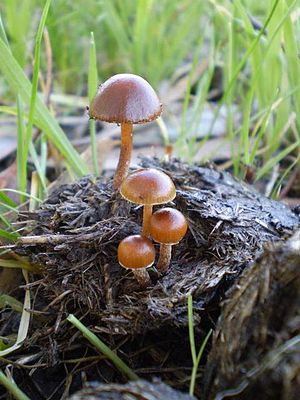Deconica coprophila
(Redirected from Psilocybe coprophila)
| Deconica coprophila | |
|---|---|

| |
| Scientific classification | |
| Kingdom: | Fungi |
| Division: | Basidiomycota |
| Class: | Agaricomycetes |
| Order: | Agaricales |
| Family: | Strophariaceae |
| Genus: | Deconica |
| Species: | D. coprophila
|
| Binomial name | |
| Deconica coprophila | |
| Synonyms[1] | |
|
Agaricus coprophilus Bull. (1793) | |
Deconica coprophila, commonly known as the dung-loving psilocybe, or dung demon, is a species of mushroom in the family Strophariaceae. First described as Agaricus coprophilus by Jean Baptiste François Pierre Bulliard in 1793,[2] it was transferred to the genus Psilocybe by Paul Kummer in 1871.[3] In the first decade of the 2000s, several molecular studies showed that the Psilocybe was polyphyletic,[4][5][6] and the non-bluing (non-hallucinogenic) species were transferred to Deconica.[7]
It can grow on cattle dung.[8]
While non-toxic, the species is not a good edible mushroom.[9]
References
- ^ "Psilocybe coprophila (Bull.) P. Kumm. 1871". MycoBank. International Mycological Association. Retrieved 2010-11-21.
- ^ Bulliard JBF. (1793). Histoire des champignons de la France (in French). Vol. 2. p. 243.
- ^ Kummer P. (1871). Der Führer in die Pilzkunde (in German) (1 ed.). p. 71.
- ^ Moncalvo JM, Vilgalys R, Redhead SA, Johnson JE, James TY, Catherine AM, Hofstetter V, Verduin SJ, Larsson E, Baroni TJ, Greg Thorn R, Jacobsson S, Clémençon H, Miller OK Jr (2002). "One hundred and seventeen clades of euagarics". Molecular Phylogenetics and Evolution. 23 (3): 357–400. doi:10.1016/S1055-7903(02)00027-1. PMID 12099793.
- ^ Nugent KG, Saville BJ (2004). "Forensic analysis of hallucinogenic fungi: a DNA-based approach". Forensic Science International. 140 (2–3): 147–57. doi:10.1016/j.forsciint.2003.11.022. PMID 15036436.
- ^ Matheny PB, Curtis JM, Hofstetter V, Aime MC, Moncalvo JM, Ge ZW, Slot JC, Ammirati JF, Baroni TJ, Bougher NL, Hughes KW, Lodge DJ, Kerrigan RW, Seidl MT, Aanen DK, DeNitis M, Daniele GM, Desjardin DE, Kropp BR, Norvell LL, Parker A, Vellinga EC, Vilgalys R, Hibbett DS (2006). "Major clades of Agaricales: a multilocus phylogenetic overview" (PDF). Mycologia. 98 (6): 982–95. doi:10.3852/mycologia.98.6.982. PMID 17486974.
- ^ Norvell L. (2009). "Report of the Nomenclature Committee for Fungi: 15" (PDF). Mycotaxon. 110: 487–92. doi:10.5248/110.487. Archived from the original (PDF) on March 31, 2012.
- ^ Pauline, N'Douba Amako; Claude, Kouassi Kouadio; Clovis, Koffi N'Dono Boni; Allal, Douira; Koutoua, Ayolié (2022). "Coprophilous fungi of Daloa city: New species for the fungal flora of Côte d'Ivoire". GSC Biological and Pharmaceutical Sciences. 20 (3): 251–260. doi:10.30574/gscbps.2022.20.3.0362.
- ^ Miller Jr., Orson K.; Miller, Hope H. (2006). North American Mushrooms: A Field Guide to Edible and Inedible Fungi. Guilford, CN: FalconGuide. p. 250. ISBN 978-0-7627-3109-1.
External links
- Deconica coprophila in Index FungorumError: "Q47528226" is not a valid Wikidata entity ID.
Error: "Q2214927" is not a valid Wikidata entity ID.
Categories:
- CS1 French-language sources (fr)
- CS1 German-language sources (de)
- Articles with short description
- Articles with 'species' microformats
- Taxonbars desynced from Wikidata
- Taxonbar pages requiring a Wikidata item
- Taxonbars with invalid from parameters
- Taxonbars with multiple manual Wikidata items
- Taxonbars without secondary Wikidata taxon IDs
- Strophariaceae
- Fungi described in 1793
- Fungi of Europe
- Fungi of North America
- Inedible fungi
- All stub articles
- Agaricales stubs